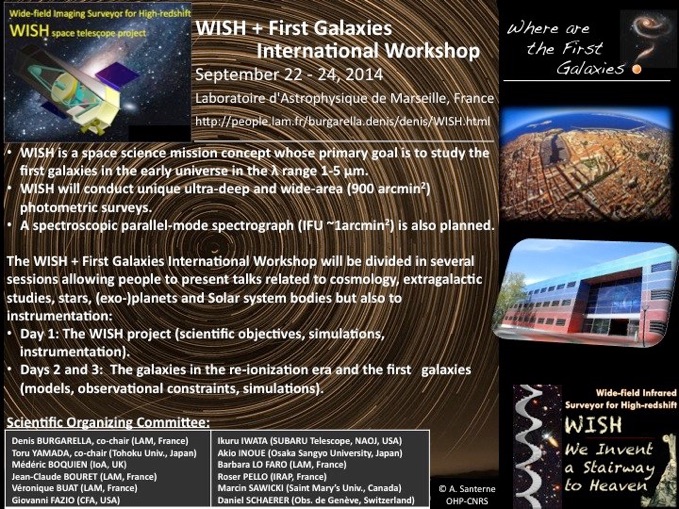2nd Joint WISH-FLARE
First Galaxies International Workshop
_____________________________________________

2nd Joint WISH-FLARE
First Galaxies International Workshop
_____________________________________________
Programme of the Workshop
Monday 22 September 2014
➡Toru YAMADA Presentation of the WISH Project
➡Denis BURGARELLA French/European contribution to WISH
➡Giovanni FAZIO Smithsonian Astronomical Observatory's contribution to WISH
➡Sebastien VIVES WISH Spec Optical Design
➡Christian SURACE WISH ETC
➡Pierre VERNAZZA Solar system small bodies
➡ Laurent PAGANI Coreshine+spectro_WISH.pdf
➡Olivier LE FEVRE EUCLID and the NISP spectrograph
➡Hervé WOZNIAK How to make the best use of WISH's IFU at low redshifts?
Tuesday 23 September 2014
➡Kiyoto YABE WISH: sentitivity and survey plan
➡Akio INOUE Emission lines of LBGs with WISH and their detectability with JWST
➡Hervé AUSSEL Emission lines of LBGs with WISH and their detectability with JWST
➡Médéric BOQUIEN Impact of star formation history on the measurement of star formation rates
➡Alessandro BOSELLI Studying nearby galaxies with WISH
➡Matthew ASHBY Status of the DEEP Spitzer/IRAC Survey S-CANDELS
➡Hector FLORES Synergy between the E-ELT and WISH
➡Joseph HORA Observing the Galaxy with WISH
➡Daniel SCHAERER z~4 to 7 LBGs: bursty, star-forming galaxies
➡Marcin SAWICKI Canadian contribution to WISH
➡Ikuru IWATA Constraining z>7 LFs with WISH UDS
Wednesday 24 September 2014
➡Rychard BOUWENS What current samples of z~9-10 candidates from CANDELS, the HUDF and the Frontier Fields tell us about future z >=10 science with WISH
➡Michele TRENTI The First Galaxies frontier: Hubble's BoRG survey and a WISH for the future
➡Erik ZACKRISSON Primordial star clusters at extreme magnification
➡Hakim ATEK The UV luminosity function at the epoch of reionisation: lessons from the Hubble Frontier Fields
➡Masami OUCHI Can Star-forming Galaxies at z~7-10 be Major Sources of Reionization? --- Hubble Frontier Fields to the WISH Project
➡Ken MAWATARI Extreme red K-3.6 galaxies at z ~ 6
➡Dominique AUBERT Radiative hydrodynamics codes for the cosmological reionization: challenges and prospects
➡Roser PELLO Detection of high redshift galaxies with WISH
➡Asantha COORAY IR Background, Fluctuations, and Spectral Line Intensity Mapping with CIBER, Hubble, Spitzer, and SPHEREx
WISH (Wide-field Infrared Surveyor for High-redshift) is a space science mission concept whose primary goal is to study the first galaxies in the early universe. WISH will be a Japan-led 1.5m telescope equipped with a 900 arcmin2 wide-field, Near-IR, 0.2-0.5arcsec FWHM, camera that would fly by ~2020 in order to conduct unique ultra-deep and wide-area sky surveys in the wavelength range 1-5 micron. A spectroscopic parallel-mode spectrograph (WISHSpec, Integral-Field Unit) in the same Near-IR range is also planned and would be studied in France under the responsibility of LAM. Although the instrument design is still open, with the parallel mode, we could envisage very deep exposure times in spectroscopy over (relatively) wide areas.
Several photometric surveys are planned (1000deg2 to AB=25, 100deg2 to AB=28 and 0.25deg2 to AB=29) that should take ~75% of the science telescope lifetime. Spectroscopically, we envision two spectroscopic surveys (10deg2 to ~8x10^-16erg/s and ~8x10^-17erg/s). They will allow to detect the first galaxies to z~15 (if any) and to physically study the first generation of stars spectroscopically at 3<z<10.
Beyond the above main science case, WISH would be excessively useful to other themes related to the Programme Nationale Cosmologie et Galaxies (PNCG) and the optimal balance between the major science drivers still needs to be defined. The aim of this workshop is therefore to help defining the science case for WISH and more specifically for the spectrograph WISHSpec by bringing together people interested in this matter. This meeting is planned to be informal with ample time for discussion.
Last but not least, WISH will be crucial because it will provide a way of selecting targets of interest for the JWST and the ELTs. It will also be complementary to other missions like Euclid/WFIRST/SPICA by providing deep data in the 1-5 micron range.
Download the programme of the workshop.
Scientific Organizing Committee
Denis BURGARELLA*, co-chair (Laboratoire d'Astrophysique de Marseille, France)
Toru YAMADA, co-chair (Tohoku University, Japan)
Médéric BOQUIEN (Institute of Astrophysics, UK)
Jean-Claude BOURET* (Laboratoire d'Astrophysique de Marseille, France)
Véronique BUAT* (Laboratoire d'Astrophysique de Marseille, France)
Giovanni FAZIO (Harvard-Smithsonian Center for Astrophysics, USA)
Ikuru IWATA (SUBARU Telescope, NAOJ, USA)
Akio INOUE (Osaka Sangyo University, Japan)
Barbara LO FARO* (Laboratoire d'Astrophysique de Marseille, France)
Roser PELLO (Institut de Recherche en Astrophysique et Planétologie, France)
Marcin SAWICKI (Saint Mary’s University, Canada)
Daniel SCHAERER (Observatoire de Genève, Switzerland)
* also LOC members
